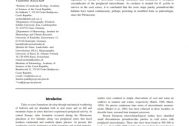Obsah
The periglacial temperature regime in cool scree slopes located at subalpine altitudes of only 300–600 m a.s.l. in the Czech highlands is described and proved by the occurrence of a relict population of the predatory mite Rhagidia gelida Thorell (Acari, Prostigmata, Rhagidiidae). The mite has a circum-boreal pattern of distribution today, but its disjunct populations have an island-like pattern of distribution in the cool screes in the Czech highlands. R. gelida is univoltine, freezing intolerant, and considered a biological cryoindicator of the periglacial microclimate. As coolness is needed for R. gelida to survive in the cool screes, it is concluded that the scree slope patchy permafrost-like habitats have lasted continuously, perhaps persisting in modified form as paleorefugia, since the Pleistocene.



